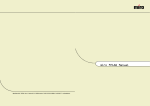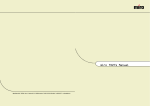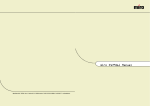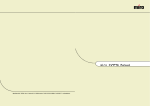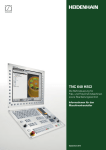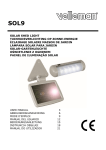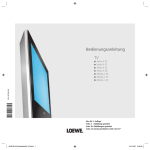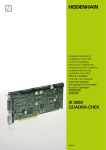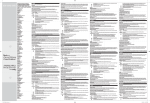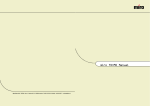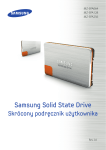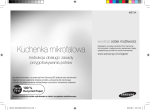Download miro TD690 Manual
Transcript
miro TD690 Manual miro Displays GmbH · TRIFORUM · Haus A1 · Frankfurter Str. 233 · D-63263 Neu-Isenburg · Tel.0180-5 22 35 26 (0.12Euro/Min) · Fax 06102-3667-77 · e-mail:kontakt@miro.de INTRODUCTION Safety Instructions ............................................................................i General Information..........................................................................1 Equipment Checklist ........................................................................2 Monitor Features ..............................................................................3 GETTING STARTED Installation ........................................................................................4 Control Buttons ................................................................................5 On-Screen Display ..........................................................................6 ON-SCREEN CONTROLS Menu Descriptions............................................................................7 REFERENCE Power Management ........................................................................9 Timing Guide ..................................................................................10 Pin Assignment ..............................................................................12 Specifications..................................................................................13 Troubleshooting..............................................................................14 English TABLE OF CONTENTS English English S AFETY I NSTRUCTIONS HANDLING Read all of these instructions. Save these instructions for later use. Due to its fragile glass panel, this monitor must be handled with caution and not exposed to impact or shock. Never touch the display area or rub it with a hard stiff object or tool, as the panel is easily scratched. CLEANING Unplug this monitor from the wall outlet before cleaning. The display area is highly prone to scratching. Do not use ketone-type cleaners (i.e. acetone), ethyl alcohol, toluene, ethyl acid or methyl chloride to clean the panel. Doing so may result in permanent damage. Water, IPA (Iso Prophyl Alcohol) and Hexane are safe cleaners. Do not allow oil or water to penetrate the display, as droplets cause staining and discoloration with time. Keep food particles and fingerprints away from the display area at all times. STORAGE Store the monitor in a dark place away from sunlight and ultraviolet (UV) radiation, as air bubbles may develop within the glass panel with time. Do not store the display in temperatures higher than 40°C/104°F or humidity greater than 90%. Avoid condensation. i G ENERAL I NFORMATION CAUTION This monitor is a high-performance intelligent multi-scan TFT LCD color monitor for IBM compatible PC and Apple Macintosh. It is designed to be compatible with all display modes for 19” inch LCD monitor. 1. Do not open any covers on the monitor. No user serviceable parts are inside. 2. In an emergency, disconnect the AC power plug. 3. To avoid electrical shock, disconnect the power cord before connecting the signal cable to the computer. 4. Keep away from liquids and flame. Do not immerse this monitor in water or any other liquid. Do not use this device in excessively hot conditions. 5. Handle the ac adapter and power cord with care. Do not bend the power cord excessively or place heavy objects on it. Do not use a damaged power cord, as doing so can result in fire or electrical shock hazards. When disconnecting the power cord, always grasp the plug, not the cord. 6. The liquid crystals in the display panel contain several irritants. If the panel is damaged or broken, do not allow the liquid to come in contact with skin, eyes, or mouth. If you come in contact with the liquid, flush the affected area with running water for at least 15 minutes, then consult a doctor. 7. Handle this monitor with care when moving it. When lifting the monitor, support it with one hand holding the stand, and one hand holding the LCD screen. 8. Always disconnect the power adapter when moving this monitor. 9. Do not lay this monitor in a horizontal position when operating. ii Your new LCD monitor has many advantages : safe from electromagnetic wave, lights, sharps and slims. This makes the monitor extremely suitable in the environment of administration, transportation system research, etc. Your new LCD monitor does not emit any X-ray radiation and the magnetic emission greatly reduces the eyestrain. Your new LCD monitor is designed for only Analog input support. User friendly interface -- the easy and precise OSD control of 5 keys button. You can use these controls to adjust the display as you desire. Brief appearance -- multimedia featured in an elegant and compact housing. Your new LCD monitor incorporates an active TFT module. It has a 1280 x 1024 pixel resolution, high contrast, high luminance and fast response time. 1 English English S AFETY I NSTRUCTIONS M ONITOR F EATURES Before operating your display, please check to make sure that all of the items listed are present in your package: * * * * • Color TFT LCD Monitor • Accessory Box: 1. AC to DC Adapter & Power Cord 2. Signal Cable 15-pin D-Sub * * 3. Audio cable 4. This manual * * * * * 5. Product CD * * * Supports Analog IBM compatible PC, Apple Macintoch TM VESA Display Data Channel (DDC) 1/2B compatible Micropocessor based with OSD (On Screen Display) control. On Screen Control : Auto Adjustment, Contrast, Brightness, Color Control, H/V Position, Sharpness, Phase, Clock, OSD-Position, OSD-Language, OSD-Time, Signal Source, Mode Select, Volume, Reset. Built-in color active matrix TFT (Thin Film Transistor) Liquid Crystal Display (LCD) that uses amorphous silicon TFTs as a switching device. Multi-scanning at horizontal frequencies of 30kHz to 91kHz and vertical frequencies of 56Hz to 85Hz. Compatible with standard IBM VGA, extended VGA, super VGA, standard IBM XGA, super XGA, as well as VESA resolution standards Resolution : up to 1280 x 1024 Dot pitch : 0.294mm(H) x 0.294mm(W) Universal power supply : AC 100 - 240V allowed Power consumption Normal : < 40 Watt Power Saving : < 3 Watt Off : < 3 Watt 2 built-in speaker (2W) Outside dimension : 415mm(W) x 415mm(H) x 190mm(D) Weight (net) : 6.0kg Note : If any item(s) are missing or damaged, contact your dealer immediately. Remove the monitor from its shipping carton. Save the carton and packaging materials in case you need to relocate the monitor. 2 3 English English E QUIPMENT C HECKLIST C ONTROL B UTTONS Follow these steps to install the monitor Front Controls 1. Before you connect the cables, make sure the monitor and system unit power switches are OFF. 2. Plug one end of the 15-pin signal cable to the rear of your system and the other end to monitor’s signal input. The adapter may be required for certain Apple Macintosh computers. Tighten the two screws on the cable connector. 3. Connect the audio cable between the monitor’s audio input and the PC’s audio output. 4. Plug the adapter connector to the power “DC-IN” jack of the LCD monitor. Plug the male end of power cord into an AC wall outlet. 5. Turn on your computer and your LCD monitor. 4 uvwxyz u v w x y z English English I NSTALLATION Auto button Select button Select button Exit button Menu button Power button (-) (+) BUTTON DESCRIPTION: u : Auto button Press "2" button 2 seconds the auto adjust display mode will tune to the utmost performance according to VGA setting. In the event of the display image needs further adjustment. To ensure best Auto-Adjustment perfomance : Press “A” button for 2 seconds The monitor display will be then best adjusted. vw : Select button To choose which function you need in OSD Menu and to increase and to decrease the function, you may click or x : Exit button To exit OSD menu as well as submenu. y : Menu button To push menu button turns on the menu, and activated highlighted function. z : Power button Use this button to turn the monitor on and off 5 MENU DESCRIPTIONS This LCD monitor features an On-Screen Display (OSD) menu. These icons are designed to make your monitor display settings easier. When highlighted, the icons illustrate the control function to assist you in identifying which control needs adjustment. COLOUR Before activating the OSD menu, the Auto button (1) can be used to automatically adjust the display to the proper size and horizontal and vertical position. (Press button for 2 seconds.) The OSD menu activates automatically when you press the Menu button (5) on the front of the monitor. The OSD remains centered on the screen while you make your adjustments. Use either the or select button to move the highlight to your selection. Pressing Menu button (5) the submenu will appear nearby main menu. Press Menu button (5) and release again, the highlight of adjusted items. Use the or select button to adjust the control. When you have finished making adjustments, press the Exit button (4) to save settings. You can select other function to make adjustment. Also you can select EXIT icon and press Menu button (5) to go back to main menu. English English ON-SCREEN DISPLAY CONTRAST This control allows you to make adjustments to the contrast of the display screen. BRIGHTNESS Selecting this control allows you to make adjustments to the luminosity level of the display screen. GAMMA CORRECT Set gamma (0) 1.0, (1) 1.1, (2) 1.2, (3) 1.3 COLOR ADJUST Select this control and adjust to the desired color temperature. WHITE BALANCE Adjust image get light and dark balance. PICTURE H. POSITION Select this control to center the image horizontally on the screen. V. POSITION Select this control to center the image vertically on the screen. SHARPNESS Select this control to adjust the picture sharpness of display PHASE Selecting this control allows you to make adjustments to the picture phase (pixel clock signal). CLOCK Selecting this control allows you to make adjustments to the picture clock (pixel frequency). OSD MENU LANGUAGE Select this control to choose on of the eight language you need. OSD H. POSITION Select this control to center the OSD menu horizontally on the screen. OSD V. POSITION Select this control to center the OSD menu vertically on the screen. 6 7 OSD TIME Select this control to set the displaying time of OSD. TRANSLUCENT Select this control to change the background of OSD. MISCELLANEOUS SIGNAL SOURCE Select the input signal source of monitor. MODE SELECT Select this control to change the mode to 640 x 400 or 720 x 400 RESET Reset default factory settings of Clock, H/V Position, Phase, Contrast, Brightness, Color Adjust, OSD Position, OSD Time and Sharpness. VOLUME To increase and decrease the volume. English English MENU DESCRIPTIONS POWER MANAGEMENT LED INDICATOR (POWER MANAGEMENT ACITVE ) The power management feature of this LCD monitor is comprised of two stages: On or Out Of Range (Green), OFF (Amber). In the off mode, all circuitry in the monitor is shut down, except for a low power detection circuit. This circuit allows the monitor to wake up when the mouse is moved or a key on the keyboard is pressed. Power Mode H-Sync V-Sync Video LED Color Normal Pulse Pulse Active Green Out Of Range Pulse Pulse Active Green Off Pulse No pulse Blanked Off No pulse Pulse Blanked Amber Off No pulse No pulse Blanked Amber Amber * Note: You can get the best quality of the image under full-screen image with a running computer. The function of AUTO-ADJUST may not work properly if background color is dark or if the input image does not fill the screen. (ex: DOS text mode) We strongly recommend that you just run the AUTO-ADJUST function to get the best image quality when you unpack the monitor or when you install different VGA card or PC. 8 9 The LCD is a multi-frequency display. It operates at horizontal frequencies between 30KHz - 91kHz and vertical frequencies between 56Hz - 85Hz. Because of its microprocessor-based design, it offers autosynchronization and auto-sizing capabilities. This monitor offers 17 preprogrammed settings that are listed in the timing table on page 11. These preset modes cover most of the common video modes supported by popular graphics adapters. However, each adapter’s implementation of these video modes may vary slightly. If you find it necessary to make minor display adjustments (for example, horizontal and vertical position). Please refer to the On Screen Display section of this manual for instructions. If you would like to use one of the preset timing modes, please refer to your video card manufacturer’s installation guide for instructions on how to make these changes. The video card controls the refresh rate. Most video cards provide a software utility or hardware DIP switches that allows you to change the frequency used for each resolution. English English TIMING GUIDE TIMING TABLE Preset Resolution Horizontal Vertical Frequency Horizontal Vertical M1 640 400 31.46kHz 70.0Hz M2 720 400 31.46kHz 70.0Hz M3 640 480 31.50kHz 60.0Hz M4 640 480 37.90kHz 72.0Hz M5 640 480 37.50kHz 75.0Hz M6 640 480 43.27kHz 85.0Hz M7 800 600 37.90kHz 60.0Hz M8 800 600 48.10kHz 72.0Hz M9 800 600 46.90kHz 75.0Hz M10 800 600 53.67kHz 85.0Hz M11 1024 768 48.40kHz 60.0Hz M12 1024 768 56.50kHz 70.0Hz M13 1024 768 60.00kHz 75.0Hz M14 1024 768 68.6kHz 85.0Hz M15 1280 1024 64.00kHz 60.0Hz M16 1280 1024 80.00kHz 75.0Hz M17 1280 1024 91.15kHz 85.0Hz Note: In case of using MacintoshTM, you may need a Mac adapter. 10 11 English English PIN ASSIGNMENT SPECIFICATIONS VGA Connector LCD Pin 1 Pin 2 Red Green Pin Pin Pin Pin 3 4 5 6 Blue NC VGA DET Ground Pin Pin Pin Pin 7 8 9 10 Ground Ground +5V Ground Pin Pin Pin Pin 11 12 13 14 NC DDC SDA Horizontal Sync. Vertical Sync. Pin 15 Type Color Filter Colors Glass surface 19” diagonal viewable screen TFT (Thin Film Transistor), Active Matrix Panel, 0.294mm pixel pitch R, G, B vertical stripe up to 16 millions (6bit+dithering) Anti-glare coating Viewing Angles (CR>10) Left / Right Up / Down 85° / 85° 85° / 85° Contrast Ratio Typ. 700:1 - since production 04/2005: 800:1 Luminance of White Typ. 250cd/m² Response Time Typ. 25ms - since production 04/2005: 20ms Compatibility PC IBM XT, AT, 386, 486, Pentium or PS/2 and compatibles (from VGA up to 1280 x 1024 @ 85 Hz NI.) Refresh Rate Max. 1280 x 1024 @ 85Hz NI (60Hz for optimal display) Connectors Input Signal 15-pin D-SUB Power Ext. Adapter Consumption AC 100-240V 50-60Hz 40 watts (Maximum) Display Area Max. 376mm (H) x 301mm (V) Operating Temperature Humidity Altitude 32°F to 104°F (0°C to 40°C) 20% RH to 90% RH (no condensation) To 10,000 feet Storage Conditions Temperature Humidity -14°F to 104°F (-20°C to 40°C) 5%RH to 90%RH (no condensation) DDC SCL Note: When resolutions are shown that are lower than the pixel count of the LCD panel, text may appear choppy or bold. This is normal all current flat panel technologies when displaying non-native resolutions on a full screen (below than 1280 x 1024 resolution). In flat panel technologies, each dot on the screen is actually one pixel, so to expand resolutions to full screen, an interpolation of the resolution must be down. When the interpolated resolution is not an exact multiple of the native resolution, the mathematical interpolation necessary may cause some lines to appear thicker than others. Audio 12 2 * 2 watt Dimension mm 415 (W) x 415 (H) x 190 (D) Weight Net 6.0kg 13 TROUBLESHOOTING No power. Double (split) screen image. ü ü Flip the power switch ON. The Power LED turns on. Make sure AC adapter is securely connected to the power jack and to a power outlet. ü ü Make sure the video cable attached with this monitor is tightly secured to the video output port on the back of the computer. Adjust the brightness and contrast. Image is unstable, unfocused. ü ü ü Use “AUTO-TUNE” to adjust automatically. If the image is still unstable after “AUTO-TUNE” processing, please adjust “PHASE” manually to get image focused. Check whether the resolution or refresh rate in windows display setting is beyond supported range(please refer to the specification of supported mode). Make sure your graphics card is set to Non-Interlaced mode. Entire screen image rolls (scrolls) vertically. ü Power on but no screent image. ü English English TROUBLESHOOTING ü ü Make sure the input signals are within the LCD monitor’s specified frequency range. (Maximum: VESA, MAC 1280 x 1024 @85Hz) Connect the video cable securely. Try the miro Monitor with another power source. Control buttons do not work. ü Press only one button at a time. Flickering. ü ü Not enough power is being supplied to the miro TD690 Monitor. Connect the miro TD690 Monitor to a different outlet. If a surge protector is being used, there may be too many devices plugged in. See Timing Guide in this manual with a list of refresh rates and frequency settings showing the recommended setting for the miro TD690 Monitor. Wrong or abnormal colors. ü ü ü 14 If any colors (Red, Green, or Blue) are missing, check the video cable to make sure it is securely connected. Loose pins in the cable connector could cause a bad connection. Connect the miro TD690 Monitor to another computer. Check the graphics card for proper sync scheme (or sync polarities) to match the miro TD690 Monitor’s specifications. A small number of missing, discolored, or lighted dots on the screen is an intrinsic characteristic of TFT LCD technology and is not an LCD defect. If you display a fixed pattern for more than 10 hours, its image may remain on the screen in overlap mode when you display something else. 15 English INHALTSVERZEICHNIS EINFÜHRUNG Allgemeine Informationen..................................................................1 Prüfliste Zubehör...............................................................................2 Gerätemerkmale................................................................................3 INSTALLATION Installation des Monitors....................................................................5 Bedienung......................................................................................... 6 OSD-Bildschirm-Menü.......................................................................7 OSD-BILDSCHIRM Menü Erläuterungen......................................................................... 8 SONSTIGES Stromsparsystem.............................................................................10 Einstellungsrichtlinien (Timing Guide)............................................. 11 Timing Table....................................................................................12 Pinbelegung.....................................................................................13 Spezifikationen................................................................................14 Im Störungsfalle.............................................................................. 15 Deutsch Sicherheitsrichtlinien...........................................................................i Vorsichtsmaßregeln für den Gebrauch des Monitors.........................i Pflege des Monitors..........................................................................iii Aufstellplatz des Monitors.................................................................iv S ICHERHEITSRICHTLINIEN VORSICHTSMAßREGELN Behandeln Sie das Gehäuse vorsichtig. • Unterlassen Sie das Öffnen des Gehäuses. Überlassen Sie Wartungs- bzw. Reparaturarbeiten ausschließlich qualifiziertem Fachpersonal. • Beim Transport des Monitors darauf achten, dass er keinen großen Erschütterungen ausgesetzt wird. • Wenn flüchtiges Lösungsmittel oder Klebstoff mit dem Gehäuse in Berührung kommt, kann die Oberfläche beschädigt oder die Farbe abgelöst werden. i Deutsch Deutsch FÜR DEN GEBRAUCH DES MONITORS Bei Ihrem Monitor handelt es sich um ein hochwertiges elektronisches Gerät. Zu Ihrer eigenen Sicherheit und um die Funktionalität des Monitors zu gewährleisten, empfehlen wir folgende Warnhinweise sorgfältig zu beachten. Behandeln Sie den Montior vorsichtig. • Reiben Sie nicht mit einem harten Gegenstand am Monitor und setzen Sie ihn keinen Schlägen aus, da er sonst beschädigt und die Anzeige zerkratzt werden kann. • Üben Sie keinen Druck auf den Flüssigkristall-Bildschirm durch Berühren oder verkratzen mit harten Gegenständen aus. • Stellen Sie keine Gegenstände auf dem Monitor ab und achten Sie darauf, dass nichts in die Belüftungsschlitze des Monitors fallen kann. Gegenstände, die durch diese Schlitze in das Innere des Monitors gelangen, können zu Beschädigungen führen. Zudem setzen Sie sich dabei der Gefahr eines elektrischen Stromschlages aus. • Falls der Monitor beschädigt ist, vermeiden Sie unbedingt den Kontakt der Flüssigkristalle mit Haut, Augen oder Mund. Die Flüssigkristalle des Monitors enthalten Reizstoffe, die schädlich sind. Falls doch Kontakt entsteht, waschen Sie die entsprechende Stelle unter fließendem Wasser gut ab und konsultieren Sie einen Arzt. • Beim Tragen des Monitors mit einer Hand den Standfuß des Monitors unterstützen mit der anderen dessen Display halten. S ICHERHEITSRICHTLINIEN Gehen Sie sorgsam mit dem Netzadapter und -kabel um. • Speziell beim unachtsamen Gebrauch des Netzadapters bzw. kabels besteht die Gefahr eines elektrischen Stromschlages. • Stellen Sie keine schweren Gegenstände auf das Netzkabel, schließen Sie keine Zweigleitungen an, verknoten Sie es nicht, und ziehen Sie nicht am Kabel, um den Stecker aus der Steckdose zu ziehen. Wenn das Netzkabel beschädigt ist, besteht Brand- und Stromschlaggefahr. • Fassen Sie den Netzstecker niemals mit nassen Händen an, da anderenfalls Stromschlaggefahr besteht. • Wenn Sie den Monitor bewegen, trennen Sie diesen immer von der Stromzufuhr. • In einer Notsituation sofort das Netzkabel von der Steckdose trennen. • Bevor Sie das Signalkabel des Monitors mit dem Computer verbinden, den Netzstecker immer vom Strom trennen. • Trennen Sie das Gerät während eines Gewitters vom Netz, aber auch dann, wenn Sie es für längere Zeit nicht verwenden. Dies schützt den Monitor vor Beschädigungen durch Spannungsspitzen. PFLEGE ii DES MONITORS • Reinigen Sie das Gehäuse des Monitors gelegentlich mit einem weichen, leicht mit Wasser angefeuchteten Tuch. • Verwenden Sie zur Reinigung der Bildfläche des Monitors auf keinen Fall Seife, Fensterputzmittel oder ähnliche Reinigungsmittel. Wischen Sie die Bildfläche ab und zu mit einem weichem, leicht mit Wasser angefeuchteten Tuch ab. • Verwendung eines chemisch behandelten Lappens oder eines glanzerzeugenden Reinigungsmittels kann die Oberfläche beschädigen oder ein Ablösen der Farbe verursachen. • Achten Sie darauf, dass kein Wasser oder Öl in die Sichtanzeige eindringen kann, da Tröpfchen im Laufe der Zeit Verfärbungen und Entfärbungen verursachen können. • Halten Sie Nahrungsmittelpartikel vom Anzeigefeld fern und hinterlassen Sie keine Fingerabdrücke darauf. iii Deutsch Deutsch S ICHERHEITSRICHTLINIEN S ICHERHEITSRICHTLINIEN A LLGEMEINE I NFORMATIONEN AUFSTELLPLATZ Wir gratulieren zum Kauf dieses hochauflösenden LCD-Monitors. Ihr LCD-Monitor ist mit der neuesten Farb-Flüssigkeitskristallanzeige (LCD-) Technologie ausgestattet. Sie bietet Ihnen bei einer Auflösung von 1280 x 1024 Bildpunkte einen hohen Kontrast und eine ausgewogene auf die gesamte Fläche des Displays verteilte Leuchtdichte. Der Monitor lässt sich auf die meisten Video-Betriebsarten sowohl bei IBM-kompatiblen PCs als auch bei Apple Macintosh-Computern synchronisieren und an diese anpassen. Der ergonomisch angepasste Flachbildschirm bietet ein erweitertes Bildschirm-Menü (OSD) mit animierten Befehls-Icons, die eine einfache und problemlose Einstellung des Monitors ermöglichen. Das vorliegende Handbuch beschreibt die Funktionen und Leistungsmerkmale des Monitors ausführlich, damit Sie ihn so effizient wie möglich einsetzen können. Schäden, die auf Missachtung obiger Warnhinweise zurückzuführen sind sowie mechanische Defekte wie z.B. Bruch des Gehäuses, Kratzer auf dem LCD-Bildschirm etc., werden nicht durch Garantieleistungen abgegolten. iv 1 Deutsch Deutsch DES MONITORS • Vermeiden Sie direktes Sonnenlicht und ultraviolette (UV-) Strahlung, die eine nachteilige Auswirkung auf Gehäuse und Teile haben. Vermeiden Sie extreme Hitze oder Kälte. • Setzen Sie den Monitor niemals einer Temperatur höher als 40°C und einer Luftfeuchtigkeit über 90% aus. • Vermeiden Sie in jedem Fall Kondensation, wird das Gerät aus einer kalten Umgebung in ein wärmeres eventuell feuchtes Umfeld gebracht, kondensiert Feuchtigkeit im Inneren Ihres Monitors. Wird anschließend der Monitor eingeschaltet, können zu diesem Zeitpunkt interne Komponenten des Monitors beschädigt werden. Aus diesem Grund warten Sie bitte mit dem Einschalten des Monitors, bis sich die Innentemperatur des Gerätes an die Umgebungstemperatur angepasst hat und eventuell entstandene Feuchtigkeit in dieser Zeit trocknen kann. • Ist der Monitor in Betrieb, legen Sie ihn nicht horizontal hin. • Stellen Sie Ihren Monitor auf eine stabile und sichere Unterlage. Sollte der Monitor fallen, können ernsthafte Schäden an dem Gerät entstehen. Außerdem besteht in diesem Fall Verletzungsgefahr. Verwenden Sie nur einen vom Hersteller empfohlenen oder mit dem Monitor gelieferten Standfuß. • Die Schlitze und Öffnungen im Monitorgehäuse dienen der Belüftung. Um einen störungsfreien Betrieb des Monitors zu gewährleisten und ihn vor Überhitzung zu schützen, dürfen Sie diese Öffnungen keinesfalls abdecken. Stellen Sie den Monitor so auf, dass eine ausreichende Luftzirkulation gewährleistet ist. P RÜFLISTE Z UBEHÖR G ERÄTEMERKMALE Bevor Sie Ihren Monitor in Betrieb nehmen, überprüfen Sie bitte den Inhalt der Verpackung auf Vollständigkeit. Folgende Komponenten sollten im Lieferumfang enthalten sein: QUALITATIV HOCHWERTIGE FLÜSSIGKRISTALL-ANZEIGEEINHEIT PLUG & PLAY 2. Signalkabel 15-pin D-Sub • Dieses Gerät entspricht der VESA® -Norm (Video Electronics Standards Association) DDC TM 1/2B (Display Data Channel) gemäß den Windows ® Spezifikationen. DIGITAL-MULTI-SCAN 3. Audio Kabel 4. Benutzerhandbuch • Dieses Gerät arbeitet mit einer Horizontalfrequenz von 30.0 ~ 91.0 kHz, einer Vertikalfrequenz von 56.0 ~ 85 Hz und einer maximalen Auflösung von 1280 (H) x 1024 (B). • Der Monitor ist mit IBM® PC-kompatiblen Geräten als auch Macintosh®-Geräten kompatibel. FORMATEINSTELLFUNKTION 5. Produkt CD Falls ein Artikel fehlt oder beschädigt ist, wenden Sie sich sofort an lhren Fachhändler. Nehmen Sie den Monitor aus dem Versandkarton. Bewahren Sie den Karton und das Verpackungsmaterial für den Fall, daß der Monitor zum Umzug o.ä. wieder verpackt werden muß, auf. 2 • Das Gerät verfügt über eine On-Screen-Display-Kontrolle. Diese ermöglicht über mehrere Einstellungspunkte eine problemlose und einfache Installation des Monitors. Folgende Einstellmöglichkeiten sind gegeben: - Auto Adjust - Helligkeit - Kontrast - Farbtemperatur - H/V-Position - Sharpness - Phase - Clock - OSD-Position - OSD-Sprachen - OSD-Time - Signal-Eingangsquelle - Wahl des Modus - Volume - Reset 3 Deutsch Deutsch • TFT Farbflachbildschirm • mitgeliefertes Zubehör: 1. Netzadapter und Netzkabel • Die 19-Zoll-Anzeigeeinheit (0.294mm Pixelabstand) und die Blendschutz-Hartbeschichtung gewährleisten geringe Reflexionen, Antistatik, hohe Auflösung und starken Kontrast mit Echtfarb-Anzeige. G ERÄTEMERKMALE I NSTALLATION DES M ONITORS STROMZUFUHR ARBEITSSCHRITTE ZUR INSTALLATION ABMESSUNGEN • Die Abmessungen des Gerätes betragen 415 x 415 x 190 mm (BxHxT) bei einem Nettogewicht von 6.0 kg. WEITERE FEATURES • 2 integrierte Lautsprecher (2W) 4 DES MONITORS Anschluss des Analog-Kabels an einen IBM PC oder kompatiblen Computer. 1. Bevor Sie die Kabel anschließen, vergewissern Sie sich unbedingt, dass sowohl der Monitor als auch Computer nicht in Betrieb und von der Stromzufuhr getrennt sind. 2. Das eine Ende des analogen Signalkabels an den Mini-D-SubAnschluss (15-pin) der Graphikkarte an Ihrem Computer und das andere auf der Rückseite des Monitors anschliessen. Die Schrauben des Signalkabels festziehen. 3. Schliessen Sie das Audiokabel an den Audio-Eingang auf der Rückseite des Monitors und an den Audio-Ausgang Ihres Computers an. 4. Um den Monitor mit der Stromzufuhr zu verbinden, schließen Sie das eine Ende des Netzadapters an den Stromanschluss auf der Rückseite des Monitors an, das andere stecken Sie in die Steckdose. 5. Schalten Sie erst Ihren Computer ein, anschliessend den Monitor. 5 Deutsch Deutsch • Die Netzspannung beträgt 100 - 240 V bei 50/60 Hz. • Stromverbrauch des Gerätes: - On mode : < 40 Watt - Power Saving : < 3 Watt - Off mode : < 3 Watt B EDIENUNG OSD-BILDSCHIRM-MENÜ Bedienelemente auf der Frontseite des Monitors Dieser Monitor verfügt über ein OSD-Bildschirm-Menü mit mehreren Einstellpunkten, um die Feinjustierung an Ihrem neuen Monitor zu erleichtern. Ist eines der Einstellpunkte hervorgehoben, werden die aktuellen Einstellungen angezeigt. BESCHREIBUNG u DER Auto Taste Auswahl Taste (-) Auswahl Taste (+) Exit Taste Menü Taste Ein / Aus Taste FUNKTIONSTASTEN : : Auto-Taste Bei längerem Drücken der Auto-Taste (2 Sekunden) wird die Funktion “Auto Adjust” durchgeführt vw : Auswahl-Taste Auswahl des Einstellungspunktes. Änderung des eingestellten Wertes. x : Verlassen des OSD Menüs bzw. Submenüs. y : Menü Taste Durch kurzes drücken der Menü-Taste wird das OSDMenü aufgerufen bzw. die markierten instellungspunkte bestätigt. z : Ein / Aus Taste Ein- und ausschalten des Monitors. 6 Sie haben die Möglichkeit die Einstellungen Ihres Monitors manuell vorzunehmen oder diese durch längeres Drücken der Auto-Taste (1) des LCD-Displays automatisiert durchzuführen. Hierbei werden folgende Einstellpunkte automatisch für den Signaleingang vom Computer durchgeführt. Einstellung der horizontalen Position, horizontalen Größe, vertikalen Position, vertikalen Feineinstellung und des horizontalen Feineinstellung. Dank dieser Funktion ist eine effektive Einstellung gewährleistet. Hinweis: Während der automatischen Einstellung keine Schirmoperationen (Maus-Cursor-Verschiebungen) vornehmen, da die Einstellung anderenfalls nicht richtig durchgeführt werden kann. Die Einstellung stets bei stillstehendem Bildinhalt vornehmen. Das OSD-Bildschirm-Menü wird durch Betätigen der Menü-Taste (5) des LCD-Displays aktiviert. Das Einstellungsfenster erscheint dann in der Mitte des Bildausschnittes. Mit den Auswahl-Tasten und wird der gewünschte Einstellungspunkt gewählt, welcher dann hervorgehoben dargestellt wird. Um diesen dann auszuwählen, um die aktuelle Einstellung zu ändern, einfach die Menü-Taste (5) drücken. Das Ändern der Einstellung erfolgt über die Auswahl-Tasten und ; mit der Exit-Taste (4) verlassen Sie das aufgerufene Menü, die Einstellungen werden automatisch gesichert. 7 Deutsch Deutsch uvwxyz u v w x y z MENÜ ERLÄUTERUNGEN MENÜ ERLÄUTERUNGEN COLOUR BILDANPASSUNG H. POSITION Einstellung der Horizontalposition des Bildes. V. POSITION Einstellung der Vertikalposition des Bildes. SCHÄRFE Einstellung der Bildschärfe. FOKUS Wählen Sie die Funktion Fokus und beseitigen Sie horizontales Flackern, Unschärfen und Streifen. TAKT Wählen Sie die Funktion Takt um vertikale Streifen zu beseitigen. OSD EINBLENDZEIT Stellen Sie die Einblendzeit des OSD-Bildschirm-Menüs ein. TRANSLUCENT Ändern Sie den Hintergrund des OSD-Bildschirm-Menüs. Deutsch Deutsch KONTRAST Einstellung des Kontrastes des Bildschirms. HELLIGKEIT Einstellung des Helligkeitswertes des Bildschirms. GAMMA KORREKTUR Einstellen der Gamma-Werte (0) 1.0, (1) 1.1, (2) 1.2, (3) 1.3 FARB-EINSTELLUNGEN Einstellung der Farbtemperatur und der einzelnen RGB-Werte. WEISS ABGLEICH Einstellung des Weiss-Abgleichs. VERSCHIEDENES SIGNAL EINGANGSQUELLE Wählen Sie die Signal-Eingangsquelle. WAHL DES MODES Wählen Sie den Modus (640 x 400 oder 720 x 400) RESET Setzt alle Einstellungen zurück. VOLUME Reguliert die Lautstärke der Lautsprecher. OSD MENU SPRACHAUSWAHL Eine der angebotenen Sprachen für das Bildschirm-Menüs wählen OSD H. POSITION Einstellung der Horizontalposition des OSD-Menüs. OSD V. POSITION Einstellung der Horizontalposition des OSD-Menüs. 8 OSD- 9 EINSTELLUNGSRICHTLINIEN (TIMING GUIDE) LED INDICATOR (POWER M ANAGEMENT ACITVE ) Der Monitor ist ein Mehrfrequenz-Bildschirm. Er arbeitet mit horizontalen Frequenzen zwischen 30 kHz ~ 91 kHz und vertikalen Frequenzen zwischen 56 Hz ~ 85 Hz. Durch sein Mikroprozessor-Design verfügt er über die Möglichkeiten einer automatischen Synchronisation und Größeneinstellung. Dieser Flachbildschirm bietet vorprogrammierte Einstellungen, die in der nachfolgenden Tabelle aufgeführt sind. Befindet sich der Monitor im Bereitschafts-, Suspend- oder Active OFF Modus, so wird der Stromverbrauch des Monitors gedrosselt, um Strom einzusparen. Wird dann die Maus bewegt oder eine Taste betätigt, schaltet sich der Monitor automatisch wieder an. APM-Status H-Sync V-Sync Video LED Color Ein Aktiv Aktiv Aktiv Grün Out Of Range Aktiv Aktiv Aktiv Grün Aus Aktiv Nicht aktiv Schwarz Aus Nicht aktiv Aktiv Schwarz Orange Aus Nicht aktiv Nicht aktiv Schwarz Orange Orange Hinweis: Anweisungen zum Betrieb entnehmen Sie bitte den Bedienungsanleitungen für die verwendete Hardware. Diese voreingestellten Betriebsarten decken die meisten der üblichen Video-Betriebsarten ab, die von den gängigen Graphikkarten unterstützt werden. Eine jede Graphikkarten-Implementierung dieser VideoBetriebsarten kann jedoch etwas unterschiedlich sein. Wenn Sie es für erforderlich halten, kleinere Bildschirmeinstellungen (z.B. Horizontal- und Vertikalposition) vorzunehmen, so lesen Sie bitte den Abschnitt "OSDBildschirm-Menü" dieses Handbuches. Dort finden Sie die entsprechenden Anweisungen. Bitte beachten Sie, dass der Flachbildschirm nicht auf diese in der Fabrik voreingestellten Einstell-Betriebsarten beschränkt ist. Er kann eigentlich durch seine Mehrfrequenzeigenschaften jedes Signal innerhalb seines Frequenzbereiches von 30 kHz ~ 91 kHz horizontal und 56 Hz ~ 85 Hz vertikal darstellen. Wenn Sie gern eine der voreingestellten Einstellmöglichkeiten nutzen möchten, so schlagen Sie im Installationsleitfaden Ihres Graphikkartenherstellers nach, ob Sie dort Anweisungen finden, wie diese Veränderungen vorzunehmen sind. Durch die Graphikkarte wird die Bildwiederholrate gesteuert. Die meisten Graphikkarten verfügen über ein Software-Hilfsprogramm oder über Hardware-Dip-Schalter, mit dem/ denen Sie die Frequenz ändern können, die bei jeder Auflösung zur Anwendung kommt. 10 11 Deutsch Deutsch STROMSPARSYSTEM TIMING TABLE Preset PINBELEGUNG Auflösung Horizontal Vertikal Frequenz Horizontal Vertikal 640 400 31.46kHz 70.0Hz M2 720 400 31.46kHz 70.0Hz M3 640 480 31.50kHz 60.0Hz M4 640 480 37.90kHz 72.0Hz M5 640 480 37.50kHz 75.0Hz M6 640 480 43.27kHz 85.0Hz M7 800 600 37.90kHz 60.0Hz M8 800 600 48.10kHz 72.0Hz M9 800 600 46.90kHz 75.0Hz M10 800 600 53.67kHz 85.0Hz M11 1024 768 48.40kHz 60.0Hz M12 1024 768 56.50kHz 70.0Hz M13 1024 768 60.00kHz 75.0Hz M14 1024 768 68.6kHz 85.0Hz M15 1280 1024 64.00kHz 60.0Hz M16 1280 1024 80.00kHz M17 1280 1024 91.15kHz Hinweis: VGA Anschluss Pin 1 Pin 2 Rot Pin Pin Pin Pin 3 4 5 6 Blau Pin Pin Pin Pin 7 8 9 10 Masse 11 12 13 14 keine Verbindung 75.0Hz Pin Pin Pin Pin 85.0Hz Pin 15 Deutsch Deutsch M1 Nachstehend finden Sie die Pinbelegung für die Verbindungsstecker. Dies dient lediglich zu Ihrer Information. Bitte versuchen Sie nicht, eigene Verbindungen zu konstruieren, da dadurch der Bildschirm beschädigt werden könnte. Grün keine Verbindung VGA DET Masse Masse +5V Masse DDC SDA Horizontal Sync. Vertikal Sync. DDC SCL Im Falle, dass Sie den Monitor an einen Macintosh anschließen möchten, benötigen Sie gegebenenfalls einen zusätzlichen Mac-Adapter. 12 13 SPEZIFIKATIONEN Bildröhre Pixelabstand Farbfilter Farben Beschichtung 19” TFT, Active Matrix LCD Panel 0.294mm R, G, B bis zu 16 Mio. (6bit+dithering) Anti-glare coating Horizontal Vertikal 85° / 85° 85° / 85° Kontrastverhältnis Typ. 700:1 - seit Produktion 04/2005: 800:1 Leuchtdichte Typ. 250cd/m² LC-Reaktionszeit Typ. 25ms - seit Produktion 04/2005: 20ms Kompatibilität PC IBM XT, AT, 386, 486, Pentium oder PS/2 und kompatibles (vom VGA bis zu 1280 x 1024 @ 85 Hz NI.) Auflösung Max. Anschlüsse Signaleingang 15-pin D-SUB Stromversorgung Eingang Leistung AC 100-240V 50-60Hz 40 watts (Maximum) 376mm (B) x 301mm (H) Inbetriebnahme 0°C bis 40°C 20% RH bis 90% RH (nicht kondensierend) Luftfeuchtigkeit Aufbewahrung Temperatur Luftfeuchtigkeit Audio -20°C bis 40°C 5%RH bis 90%RH (nicht kondensierend) Symptom Die BetriebsLED leuchtet nicht. Keine Anzeige. Die BetriebsLED geht nicht aus. Überprüfung Abhilfe Netzkabel/ Stecker Das Netzkabel korrekt an die Steckdose anschließen. Ein- & Austaste Drücken Sie die Ein- und Austaste. Signalkabel Schließen Sie das Signalkabel richtig an. Computer (Die Stromsparfunktion kann aktiv sein. In diesem Fall leuchtet die BetriebsLED gelb.) Schalten Sie die Stromsparfunktion aus. (Betätigen Sie hierzu die Maus oder die Tastatur. Einzelheiten lesen Sie bitte in der Bedienungsanleitung für die verwendete Hardware nach.) Kontrast, Helligkeit und Hintergrundbeleuchtung Den Kontrast, die Helligkeit und die Hintergrundbeleuchtung richtig einstellen. Steckdose Überprüfen Sie die Steckdose, indem Sie testen, ob ein anderes elektr. Gerät an ihr funktioniert. 2 * 2 Watt Abmessungen mm 415 (B) x 415 (H) x 190 (T) Gewicht Netto 6.0 kg 14 Beachten Sie bitte die folgenden Punkte 1280 x 1024 @ 85Hz NI (60Hz optimal) sichtbare Arbeitsfläche Max. Temperatur Falls sich die Störungen auch nach Durchführung der nachstehenden Überprüfungen nicht beseitigen lassen, sollten Sie den Netzstecker abziehen und sich an Ihren Händler wenden. 15 Deutsch Deutsch Blickwinkel (CR>10) Typ IM STÖRUNGSFALLE IM STÖRUNGSFALLE IM STÖRUNGSFALLE Beachten Sie bitte die folgenden Punkte Symptom Überprüfung Vert. oder hor. Streifen auf dem Ist Phase Schirm. eingestellt? Nachbild 16 Flüssigkristallanzeige Abhilfe Nehmen Sie die gewünschten Einstellungen über das OSDBildschirm-Menü vor. Symptom Auch nach der Einstellung sind die Zeichen noch undeutlich. Wenn dasselbe Bild über längere Zeit angezeigt bleibt, kann der Bildschirm "einbrennen", so dass Schatten des eingebrannten Bildes zurückbleiben, wenn andere Bildschirminhalte angezeigt werden. Vorübergehende BildschirmEinbrennungen können auftreten, wenn ein Bild über längere Zeit angezeigt wird. In diesem Fall sollten Sie den Monitor etwa einen Tag lang nicht verwenden, und den Strom nicht einschalten. Einstellungen Phase Abhilfe Nehmen Sie die notwendigen Einstellungen vor, bis die auf dem Bildschirm angezeigten Zeichen nicht mehr flimmern. Überprüfen Sie den Videosignalpegel vom Computer und stellen Sie ihn richtig ein. Vermindern Sie die Vertikalfrequenz des Bildsignals, um die Videotaktfrequenz auf einen pegel (157.5 MHz)? Pegel unter dem Standardpegel (157.5 MHz) einzustellen. M Überschreitet die Videotaktfrequenz des Bildsignals den Standard- Das Bild ist zu dunkel. Ist die Helligkeit oder der Kontrast ganz zurückgedreht? Den Kontrast, die Helligkeit und die Hintergrundbeleuchtung richtig einstellen. (Weitere Einzelheiten entnehmen Sie bitte der Bedienungsanleitung für den verwendeten Computer.) Ist der Videopegel richtig eingestellt? Überprüfen Sie den Videosignalpegel vom Computer und stellen Sie ihn richtig ein. Signalkabel Das Signalkabel richtig anschliessen. Lesen Sie in der ComputerBedienungsanleitung nach, und ändern Sie die Anzeigebetriebsart Ihres Computers entsprechend. So einstellen, dass keine Streifenmuster bemerkbar sind. Das Desktop-Muster ändern. Überprüfung M Die Anzeigefarbe ist nicht normal. Überprüfen Sie die Video-Ausgangsbetriebsart vom Computer Bildschirmgröße Befindet sich das und wählen Sie eine Betriebsart Eingangsund -position innerhalb des Monitor-Betriebsändern sich nicht. synchronsignal bereichs. (Einzelheiten entnehmen innerhalb des Betriebsbereichs? Sie bitte der Bedienungsanleitung der verwendeten Hardware.) 17 Deutsch Deutsch Das Bild ist zu groß oder zu klein. Es ist von Ist die Betriebsart nicht geder richtigen Position versetzt. speichert? Ein Teil des Bildes fehlt. Die Farbe eines Teils des Bildes ist verändert. Ist die Betriebsart garantiert? Beachten Sie bitte die folgenden Punkte IM STÖRUNGSFALLE Beachten Sie bitte die folgenden Punkte Symptom Überprüfung Abhilfe VGA350- oder DOS-PromptModus verwendet? Den Windows-Schirm umschalten oder die Einstellung manuell durchführen. Die Tasten an der Vorderseite funktionieren nicht. Werden zwei oder mehr Tasten Betätigen Sie jeweils nur eine Taste. gleichzeitig betätigt? Deutsch Deutsch Die Grössenautomatik-Einstellung funktioniert nicht richtig. Eine kleine Anzahl fehlender, entfärbter oder dauerhaft erleuchteter Punkte auf dem Bildschirm ist beim heutigen Stand der Technik möglich. Sie bedeuten keinen LCD-Defekt und stellen somit keinen Reklamationsgrund dar. Auf Anforderung senden wir Ihnen gerne die Spezifikation für die "Pixelfehler" zu. Wenn Sie ein festes Muster über einen Zeitraum von mehr als 10 Stunden auf Ihrem Bildschirm darstellen lassen, führt dies zum "Einbrennen", d.h. dass dieses Muster sich dann mit neuen Bildschirminhalten überlagert. 18 19 TABLE DES MATIÈRES INTRODUCTION Deutsch Recommandations pour la sécurité ..................................................i Informations générales ....................................................................1 Vérification de la livraison de l'équipement ......................................2 Caractéristiques du moniteur ............................................................3 INSTALLATION Commandes frontales ......................................................................5 Menu écran ......................................................................................6 Description des menus ....................................................................7 RÉFÉRENCE Mode économie d’énergie du moniteur ............................................9 Table des fréquences......................................................................10 Connecteur VGA D-shell ................................................................12 Caractéristiques techniques............................................................13 Diagnostic d'erreurs ........................................................................14 Francais MENU ÉCRAN R ECOMMANDATIONS POUR LA SÉCURITÉ MANIPULATION En raison de son panneau de verre fragile, ce moniteur doit être manipulé avec précaution et ne pas recevoir de coups. Ne touchez pas à la zone d'affichage et ne passez pas dessus d'objet dur car le panneau peut être facilement rayé. NETTOYAGE STOCKAGE Gardez le moniteur dans un endroit sombre à l'abri du soleil et des rayons ultraviolets (UV), car il se pourrait qu'apparaissent des bulles d'air à l'intérieur du panneau de verre. Ne le gardez pas non plus à un endroit où la température pourrait dépasser 60°C/ 140° F ou le taux d'humidité être supérieur à 85%. Evitez la condensation. i Francais Francais La zone d'affichage est très facile à rayer. N'utilisez pas de produits de type cétogène comme l'acétone, de l'alcool éthylique, du toluène, de l'acide éthylique ou du chlorure de méthyle pour nettoyer le panneau. Ces produits risquent de détériorer le panneau pour toujours. De l'eau, des produits pour laver les vitres ou des produits TFT spéciaux sont sans danger. Faites attention que de l'eau ou des produits huileux ne s'infiltrent pas à l'intérieur de l'écran, car avec le temps le verre deviendrait taché et perdrait sa couleur. Evitez le contact avec tous types de nourriture et ne touchez jamais la surface de l'écran avec les doigts. R ECOMMANDATIONS POUR LA SÉCURITÉ I NFORMATIONS GÉNÉRALES PRÉCAUTION Votre nouveau moniteur LCD utilise la toute dernière technologie des LCD (écran à cristaux liquides) couleur, offrant un angle de visualisation plus large et un taux de contraste supérieur lors de son utilisation avec les PC IBM compatibles et les Apple Macintosh. ii Votre nouveau moniteur LCD a beaucoup d'avantages : il n'est pas sensible aux faisceaux hertziens ni à la lumière. Il est donc facilement utilisable dans les bureaux, les ateliers, les laboratoires de recherche, etc. Votre nouveau moniteur LCD admet uniquement les entrées analogiques. Votre nouveau moniteur LCD est de type VESA ou compatible et peut être fixé au mur. Votre nouveau moniteur LCD n'émet pas de rayons X et ses radiations magnétiques réduisent considérablement la fatigue oculaire. En outre, les commandes d'écran sur le côté du panneau sont faciles et simples à utiliser. Utilisez ces commandes pour régler l'écran à votre convenance. Votre nouveau moniteur LCD est équipé d'un module TFT actif. Il possède une résolution de 1280 x 1024 pixels, un contraste élevé, un angle de visualisation très ouvert et jusqu'à 16 millions de couleurs. 1 Francais Francais 1. N'ouvrez aucun des éléments du boîtier du moniteur. Les pièces à l'intérieur ne nécessitent pas d´être changées par l'utilisateur. 2. En cas de danger, débranchez le câble d'alimentation de la prise secteur. 3. Pour éviter les décharges électriques, débranchez le cordon d'alimentation de l'adaptateur d'alimentation avant de connecter le câble des signaux à l'ordinateur. 4. N'approchez pas de liquides ni de flammes de l'écran. Ne plongez pas le moniteur dans de l'eau ou tout autre liquide. Ne l'utilisez pas dans des endroits particulièrement chauds. 5. Manipulez le cordon d'alimentation avec précaution. Ne le coudez pas et veillez à ne pas poser d'objets lourds sur ce cordon. N'utilisez pas un cordon d'alimentation en mauvais état, car vous risqueriez de provoquer des étincelles ou des décharges électriques. Pour débrancher le cordon d'alimentation, tirez au niveau la prise et non sur le câble lui-même. 6. Les cristaux liquides du panneau de l'écran contiennent des substances irritantes. Si le panneau est détérioré ou cassé, veillez à ce que le liquide n'entre pas en contact avec la peau, les yeux ou la bouche. Si c'était le cas, lavez à grande eau la zone affectée pendant au moins 15 minutes, puis consultez un médecin. 7. Si vous devez déplacer le moniteur, manipulez-le avec précaution. Pour le soulever, saisissez le pied d'une main et l'écran LCD de l'autre main. 8. Débranchez toujours le cordon d'alimentation avant de déplacer le moniteur. 9. Ne séparez pas le panneau LCD de son support et ne l'utilisez pas sans celui-ci. 10. Ne mettez pas le moniteur à l'horizontale quand il fonctionne. 11. Débranchez l'appareil pendant les orages ou s'il ne doit pas être utilisé pendant longtemps. Cette précaution permettra de protéger le moniteur contre les risques de surcharges électriques. C ARACTÉRISTIQUES DU MONITEUR Avant de mettre en service votre moniteur, vérifiez que l'emballage contient tous les éléments suivants : * Prise en charge des signaux analogiques des PC IBM compatibles et des Apple Macintosh (adaptateur optionnel) * Prise en charge du DPMS pour le mode économie d'énergie du moniteur * Prise en charge de DDC1/2B * 2 haut-parleurs (2W) * Commandes à l’écran : mise au point automatique, contraste, luminosité, contrôle couleur, positionnement H/V, Focus, Clock, positionnement OSD, langue OSD, Input Selected, Audio, Recall * Ecran LCD (écran à cristaux liquides) couleur TFT (transistor à couches minces) à matrice active utilisant des TFT de silicium amorphe comme élément de commutation * Résolution max. analogique Entrée: 1280 x 1024 @ 85Hz * Couleurs : jusqu’à 16 millions de couleurs * Espacement des points : 0.294mm(I) x 0.294mm(L) * Fréquence de balayage analogique Entrée 30kHz ~ 91kHz (H), 55Hz ~ 85Hz (V) * Alimentation universelle : AC 100 - 240V ac * Consommation électrique utilisation normale : 40 watts max. en attente : 3 watts max. inactif : 3 watts max. * Dimensions extérieures : 415mm(L) x 415mm(I) x 190mm(h) * Poids (net) : 6.0kg • Moniteur LCD TFT couleur • Une boîte d'accessoires avec : 1. Un adaptateur courant alternatif/courant continu et un cordon d'alimentation Francais 2. D-sub de 15 broches 3. Audio câble 4. Guide d'installation 5. CD Le moniteur est équipé d'une alimentation électrique autoadaptable fonctionnant sous des tensions allant de 100–120 V à 200–240 V ac à 50/60Hz. Vérifiez la tension du secteur puis enfichez le câble d'alimentation dans une prise électrique. 2 3 Francais VÉRIFICATION DE LA LIVRAISON DE L'ÉQUIPEMENT C ÂBLE D’ALIMENTATION C OMMANDES FRONTALES Source d’alimentation: 1. Ce moniteur LCD est muni d'une alimentation universelle qui permet le fonctionnement avec une tension de 100-240V CA (Ne nécessite aucun réglage de l'utilisateur.) 2. Connectez le cordon d'alimentation CA à la prise d'entrée d’alimentation “POWER IN” de votre moniteur LCD. Connectez l’autre fin du cordon d’alimentation CA à une prise murale. Commandes frontales uvwxyz u v w x y z Bouton d’automatique Bouton sélectionner (-) Bouton sélectionner (+) Bouton de finir Bouton menu Bouton Power Description des commandes: Francais Abandonne les commandes à l'écran. Fonction de 'mise au point automatique' (maintenez enfoncée cette touche pendant deux secondes). v w Déplace l'icône sélectionnée vers le bas / haut pour sélectionner une des commandes. Diminution / Augmentation de la valeur de commande. x Finir le menu y Affiche le menu de commandes d'écran. Sélection du menu de commandes. z Bouton Power 4 5 Francais u MENU ÉCRAN Ce moniteur LCD dispose d'icônes du menu écran (OSD - On-Screen Display) pour que vous puissiez régler plus facilement les paramètres du moniteur. Lorsqu'elles sont en surbrillance, les icônes indiquent la fonction vous permettant d'identifier les commandes qui doivent être réglées. Avant d'activer le menu OSD, vous pouvez, au moyen du bouton d’automatiqe, régler automatiquement les dimensions et les positions horizontale et verticale de l'affichage (appuyez sur le bouton pendant 2 secondes). Lorsque vous avez fini les réglages, appuyez sur le bouton de finir pour les enregistrer et revenir au menu principal. 6 COULEUR CONTRASTE (CONTRAST) Cette commande permet de régler le contraste des visualisations à l'écran. LUMINOSITÉ (BRIGHTNESS) Cette commande permet de régler le niveau de luminosité des visualisations à l'écran. GAMMA (GAMMA CORRECT) Met gamma (0) 1.0, (1) 1.1, (2) 1.2, (3) 1.3 CONTRÔLE COULEUR (COLOR ADJUST ) Sélectionnez cette commande et utilisez les boutons '+' et '-' pour rechercher la température de couleur voulue. WHITE BALANCE (WHITE BALANCE) Régler l'image équilibre léger ou foncé L’IMAGE POSITION H (H-POSITION) Sélectionnez cette commande et utilisez le bouton '+' ou ‘-’ pour centrer l'image horizontalement sur l'écran. POSITION V (V-POSITION) Sélectionnez cette commande et utilisez les boutons '+' ou '-' pour centrer l'image verticalement sur l'écran. ACUITÉ (SHARPNESS) Sélectionnez cette commande de réglage acuité d’image. PHASE (PHASE) Sélectionnez cette commande et régler l'image à l'écran jusqu'à ce qu'elle soit au point, précise et nette. CLOCK (CLOCK) Sélectionnez cette commande et régler l’image à l’écran jusqu’à ce qu’elle soit au point, précise et nette. 7 Francais Francais Le menu OSD s'active automatiquement lorsque vous appuyez sur le bouton Menu au bas du moniteur. Le menu OSD reste au centre de l'écran pendant que vous faites les réglages. Déplacez la surbrillance à l'aide des boutons '+' ou '-' pour l'amener sur votre sélection. Un sousmenu ou une commande apparaît avec une barre d'état. La barre d'état indique le sens, selon les pré-réglages faits en usine, des réglages à effectuer. Réglez la commande à l'aide des boutons '+' ou '-'. DESCRIPTION DES MENUS DESCRIPTION DES MENUS MENU OSD GESTION DE L'ALIMENTATION L'alimentation de ce moniteur LCD comprend trois phases : allumé ou hors commande (voyant vert), en attente (voyant orange), en suspens ou inactif (voyant orange/vert clignotant). Dans les modes en attente, en suspens ou inactif, tous les circuits du moniteur sont hors tension, excepté le circuit de détection de tension insuffisante. Ce circuit permet au moniteur de se réveiller lorsque vous bougez la souris ou que vous appuyez sur une touche du clavier. Mode d'alimentation Couleur du voyant Sous tension (fonctionnement normal) Hors commande En attente En suspens Inactif vert vert orange vert (orange clignotant une fois par seconde) vert (orange clignotant une fois toutes les 2 sec.) DIVERS SOURCE DU SIGNAL (SIGNAL SOURCE) Sélectionnez d’entrée du signal vidéo. SÉLECTION DU MODE (MODE SELECT) Sélectionnez cette commande pour changer du mode : 640 x 400 ou 720 x 400 RAPPEL DE MÉMOIRE (RESET ) VOLUME Augmentez la volume. * Note: Vous pouvez obtenir une qualité optimale d'une image plein écran provenant d'un ordinateur. La fonction de 'mise au point automatique' peut ne pas fonctionner correctement si la couleur de fond est foncée ou si l'image reçue ne remplit pas l'écran (par ex., en mode texte DOS). Nous vous recommandons fortement d'exécuter les fonctions 'niveau automatique' et 'mise au point automatique' pour obtenir la meilleure qualité d'image après avoir déballé le moniteur ou après avoir installé une carte graphique différente sur le PC. 8 9 Francais Francais LANGUE (LANGUAGE) Sélectionnez cette commande et utilisez les boutons '+' et '-' pour choisir le langue. POSITION H OSD (OSD H-POSITION) Sélectionnez cette commande et utilisez le bouton '+' ou ‘-’ pour centrer le menu OSD horizontalement sur l'écran. POSITION V OSD (OSD V-POSITION) Sélectionnez cette commande et utilisez les boutons '+' ou '-' pour centrer le menu OSD verticalement sur l'écran. TEMPORISATION OSD (OSD TIME-OUT) Sélectionnez cette commande pour sélectionner le temps de durée pour le menu OSD. Utilisez les boutons '+' et '-' pour sélectionner la durée (5, 15, 30 ou 60 secondes). TRANSLUCIDE (TRANSLUCENT) Sélectionnez cette commande pour changer le couleur du menu OSD MODE ÉCONOMIE D’ÉNERGIE DU MONITEUR TABLE DES FRÉQUENCES Le LCD est un écran multifréquence. Il fonctionne à des fréquences horizontales de 30 à 91 kHz et à des fréquences verticales de 56 à 85 Hz. Grâce à sa structure basée sur un microprocesseur, il dispose des caractéristiques de synchronisation et de dimensionnement automatiques. Ce moniteur possède 17 réglages préprogrammés qui sont indiqués dans le tableau ci-après. Ces modes préréglés couvrent la plupart des modes vidéo courants pris en charge par les adaptateurs graphiques du marché. Mais la mise au point des modes vidéo peut varier d'un adaptateur à un autre. Si vous estimez néces-saire d'effectuer quelques petits réglages de l'écran (comme les positions horizontale et verticale), vous trouverez les instructions correspondantes à la section 'Commandes frontales' de ce manuel. 10 Résolution M1 Fréquence Horizontale Verticale Horizontale 640 400 31.46kHz Verticale 70.0Hz M2 720 400 31.46kHz 70.0Hz M3 640 480 31.50kHz 60.0Hz M4 640 480 37.90kHz 72.0Hz M5 640 480 37.50kHz 75.0Hz M6 640 480 43.27kHz 85.0Hz M7 800 600 37.90kHz 60.0Hz M8 800 600 48.10kHz 72.0Hz M9 800 600 46.90kHz 75.0Hz M10 800 600 53.67kHz 85.0Hz M11 1024 768 48.40kHz 60.0Hz M12 1024 768 56.50kHz 70.0Hz M13 1024 768 60.00kHz 75.0Hz M14 1024 768 68.60kHz 85.0Hz M15 1280 1024 64.00kHz 60.0Hz M16 1280 1024 80.00kHz 75.0Hz M17 1280 1024 91.15kHz 85.0Hz Francais Francais Si vous voulez utiliser un des modes de fréquences préréglés, consultez le guide d'installation du fabricant de la carte graphique pour savoir comment faire les modifications nécessaires. La carte graphique définit la taux de rafraîchissement. La plupart des cartes graphiques disposent d'un utilitaire logiciel ou d'interrupteurs DIP pour que vous puissiez changer la fréquence de chaque résolution. TABLE DES FRÉQUENCES 11 CONNECTEUR VGA D-SHELL Affectation des broches Rouge Vert Bleu Non affecté Masse Rouge masse Vert masse Bleu masse Non affecté Masse Non affecté DDC SDA Sync. horizontale Sync. verticale DDC SCL LCD Angles de visualisation (CR>10) Type écran TFT (transistor à film mince) de 19" en diagonale, panneau à matrice active, espacement entre pixel de 0,294 mm Filtre couleur bande R, V, B verticale Couleurs 16 millions Surface du verre revêtement antireflets Gouche/ Droit 85° / 85° Vers le haut/bas 85° / 85° Taux de contraste Typ. 700:1 - depuis production 04/2005: 800:1 Luminance du blanc Typ. 250cd/m² Temps de réponse Typ. 25ms - depuis production 04/2005: 20ms Compatibilité PC IBM XT, AT, 386, 486, Pentium ou PS/2 et compatibles (de VGA à 1280 x 1024 @ 85 Hz NI.) Taux de rafraîchissement Max. 1280 x 1024 @ 85Hz NI (60Hzpour affichage optimal) Connecteurs Signal d’entrée D-sub à 15 broches Prise type cc + 12V In Note: Si les résolutions sont inférieures au nombre de pixels du panneau LCD, les textes peuvent apparaître hachés ou en caractères gras. Ceci est normal avec toutes les technologies d'écran plat actuelles lorsque vous visualisez des résolutions non natives sur un plein écran (résolution inférieure à 1280 x 1024). Dans les technologies d'écran plat, chaque point de l'écran est réellement un pixel ; lorsque la résolution s'étend à tout l'écran, une interpolation de la résolution doit donc être effectuée. Si la résolution interpolée n'est pas un multiple exact de la résolution native, l'interpolation mathématique peut faire apparaître quelques lignes plus épaisses. Puissance Entrée AC 100-240V 50-60Hz moniteur DC 12V Consommation 40 watts (max) Surface d’affichage Max. 376mm (H) x 303mm (V) Fonctionnement Température Humidité Altitude 32°F à 122°F (0°C à 50°C) 0% RH à 80% RH (sans condensation) jusqu’à 3048 mêtres Conditions de stocage Température Humidité 0%RH à 90%RH (sans condensation) Audio 12 -14°F à 140°F (-20°C à 60°C) 2 * 2 watts Dimension mm 415 (L) x 415 (I) x 190 (H) Poids Net 6.0kg 13 Francais Francais Broche 1 Broche 2 Broche 3 Broche 4 Broche 5 Broche 6 Broche 7 Broche 8 Broche 9 Broche 10 Broche 11 Broche 12 Broche 13 Broche 14 Broche 15 CARACTÉRISTIQUES TECHNIQUES DIAGNOSTIC D'ERREURS DIAGNOSTIC D'ERREURS Pas d'alimentation. Double image (fractionnée). ü ü Mettez l'interrupteur de mise sous tension sur 'On'. Le voyant de mise sous tension doit s'allumer. Vérifiez que le cordon d'alimentation est bien enfiché dans la prise d'alimentation et dans une prise du secteur. ü Toute l'image se déplace verticalement. ü Le moniteur est sous tension mais il n'y a pas d'image à l'écran. ü ü Vérifiez que le câble des signaux du moniteur est bien connecté au port de la sortie vidéo à l'arrière de l'ordinateur. Réglez la luminosité et le contraste. Assurez-vous que la carte graphique est réglée sur le mode non entrelacé. ü ü Vérifiez que les signaux d'entrée sont compatibles avec la gamme des fréquences du moniteur LCD (maximum: VESA, MAC 1280 x 1024 à 85 Hz). Connectez bien le câble vidéo. Essayez le miro moniteur avec une autre source d'alimentation. Les boutons des commandes ne fonctionnent pas. L'image est instable et pas mise au point. ü Utilisez la 'mise au point automatique' pour un réglage automatique. Si l'image est encore instable après l'exécution de la 'mise au point auto-matique', réglez manuellement la 'phase' pour mettre l'image au point. Vérifiez si la résolution ou le taux de rafraîchissement de la configuration Windows sont parmi les valeurs prises en charge (voir les spécifications du mode). ü N'appuyez que sur un bouton à la fois. Francais Francais ü ü Scintillements. ü ü La technologie TFT élimine tout scintillement, même à des taux de rafraîchissement faibles. Consultez la 'Table des fréquences' dans ce manuel qui contient la liste des taux de rafraîchissement et les valeurs des fréquences avec les réglages recommandés pour le moniteur. Un réglage optimal de 1280 x 1024 à 85 Hz est recommandé pour ce moniteur. Couleurs fausses ou anormales. ü ü ü 14 Si certaines couleurs (rouge, vert ou bleu) sont manquantes, vérifiez que le câble vidéo est bien connecté. Des broches tordues ou cassées sur le connecteur du câble peuvent provoquer une mauvaise connexion. Connectez le moniteur à un autre ordinateur. Vérifiez que la synchronisation ou les polarités de la carte graphique correspondent aux spécifications du moniteur. Un petit nombre de points manquants, sans couleur ou allumés est une caractéristique intrinsèque de la technologie TFT LCD et n'est pas un défaut du LCD. Si vous visualisez une image fixe pendant plus de 10 heures, cette image peut demeurer sur l'écran superposée à une autre visualisation. 15 Spis treści WSTĘP Zasady bezpiecznego użytkowania ....................................................... i Informacje ogólne .................................................................................1 Zawartość opakowania .........................................................................2 Specyfikacja monitora...........................................................................3 PIERWSZE URUCHOMIENIE Podłączenie monitora ...........................................................................4 Przyciski kontrolne ................................................................................5 Wyświetlanie funkcji na ekranie (OSD)…………………………………..6 PRZYCISKI FUNKCJI OSD Opis menu OSD....................................................................................7 OPIS PODSTAWOWYCH WŁAŚCIWOŚCI Funkcje zarządzania poborem energii..................................................9 Tabela ustawień fabrycznych...………………………………………….11 Opis pinów złącza kabla sygnałowego ...............................................12 Specyfikacja techniczna monitora miroTD690....................................13 Eliminacja podstawowych usterek eksploatacji monitora ...................14 Polish Polish ZASADY BEZPIECZNEGO UŻYTKOWANIA Przed uruchomieniem monitora miroTD690 prosimy zapoznać się z niniejszą instrukcją obsługi i korzystać z niej także w przyszłości. TRANSPORT Ze względu na kruchość materiału, z którego wykonana jest matryca, monitor należy transportować ostrożnie, nie narażając na uderzenia i wstrząsy. Nigdy nie należy dotykać i pocierać monitora twardymi lub ostrymi przedmiotami ponieważ może to spowodować zarysowanie. CZYSZCZENIE Przed czyszczeniem należy odłączyć monitor od źródła zasilania. Płyta główna jest bardzo podatna na zarysowania. Do jej czyszczenia nie należy także używać środków czyszczących na bazie ketonu (np. aceton), alkoholu etylowego, toluenu, kwasu etylowego, chlorku metylu, ponieważ mogą one spowodować trwałe uszkodzenia. Bezpiecznymi środkami czyszczącymi izopropylowy) oraz heksan. są woda, IPA (alkohol Nie należy dopuścić aby woda lub olej przedostały się do wnętrza monitora ponieważ z czasem może to spowodować plamy i przebarwienia na ekranie. Polish Polish Unikać poplamienia płyty głównej jedzeniem i dotykania jej palcami. PRZECHOWYWANIE Monitor należy przechowywać w ciemnym miejscu, z daleka od światła słonecznego i źródła promieniowania ultrafioletowego, ze względu na możliwość tworzenia się pęcherzyków powietrza wewnątrz szklanego panelu. Nie należy przechowywać wyświetlacza w temperaturze powyżej 40*C/104*F oraz przy wilgotności powietrza powyżej 90%. Unikać kondensacji. i INFORMACJE OGÓLNE 1. Nie należy otwierać obudowy monitora. Wewnątrz nie znajdują się żadne elementy regulacyjne dostępne dla użytkownika. 2. W przypadku zagrożenia, należy natychmiast odłączyć przewód zasilający zasilacza od sieci. 3. Przed podłączeniem kabla sygnałowego do komputera, należy odłączyć kabel zasilający w celu uniknięcia przeciążenia prądowego. 4. Monitor należy chronić przed zawilgoceniem, zalaniem i ogniem. Nie wolno zanurzać monitora w żadnej cieczy lub płynie. Nie należy używać monitora w zbyt mocno nagrzanych pomieszczeniach. Nigdy nie należy wystawiać monitora na działanie deszczu lub nadmiernej wilgoci, ponieważ może to grozić zwarciem elektrycznym, porażeniem lub pożarem. 5. Kabel zasilający powinien być podłączany delikatnie i z należytą starannnością. Nie wolno zginać kabla ani stawiać na nim ciężkich przedmiotów. Nie należy używać uszkodzonego kabla zasilającego, ponieważ może to spowodować porażenie prądem elektrycznym lub pożar. Przy odłączaniu kabla od sieci zasilającej, należy zawsze trzymać w ręku wtyczkę, a nie kabel. 6. Ciekłe kryształy wykorzystane do produkcji matrycy monitora miroTD690 zawierają szereg potencjalnie szkodliwych dla zdrowia składników. W przypadku mechaniczego uszkodzenia matrycy należy chronić skórę, oczy oraz usta przed płynem mogącym wyciekać z matrycy ekranu. Gdyby jednak doszło do kontaktu ciekłego kryształu z ciałem, podrażnioną powierzchnię ciała należy przemywać pod bieżącą wodą przez co najmniej 15 minut oraz natychmiast skontaktować się z lekarzem. 7. Monitor miroTD690 należy przemieszczać lub przenosić bardzo ostrożnie. W trakcie przenoszenia, jedną ręką należy trzymać podstawkę monitora, a drugą obudowę matrycy LCD. 8. Należy zawsze odłączyć monitor od źródła zasilania przed przeniesieniem monitora w inne miejsce. 9. Nie należy używać monitora miroTD690 kładąc go poziomo na powierzchni np. blatu biurka lub stołu. Monitor miroTD690 został zaprojektowany tak, aby spełniać warunki kompatybilnego użytkowania we wszystkich ustawieniach zgodnych ze specyfikacją dla 19 calowych monitorów LCD, zarówno dla środowiska użytkowników PC, jak i Apple Macintosh. Monitor miroTD690 posiada cały szereg zalet: jest całkowicie bezpieczny pod względem emisji fal elektromagnetycznych i światła, pozbawiony zniekształceń i rozmycia obrazu co sprawia, że jest niezwykle przydatny w administracji, pracy w biurze, biznesie, transporcie. Monitor miroTD690 nie emituje nawet najmniejszego promieniowania o częstotliwościach rentgenowskich, a emisja pola magnetycznego jest na tyle znikoma, że nie stwarza najmniejszego zagrożenia dla wzroku. Monitor miroTD690 posiada tylko wejście analogowe sygnału. Monitor miroTD690 posiada interfejs przyjazny użytkownikowi – łatwe i precyzyjne menu funkcji wyświetlane na ekranie za pomocą 5 przycisków (funkcja OSD). Za pomocą tej funkcji można ustawiać parametry dostosowując je do indywidualnych preferencji użytkownika. Monitor TD690 ma także elegancki i nowoczesny wygląd. Monitor miroTD690 wykonany jest w technologii aktywnej matrycy TFT, jego rozdzielczość wynosi 1280 x 1024, ma wysoki kontrast i luminację, oraz szybki czas reakcji plamki. Polish Polish ii ZASADY BEZPIECZNEGO UŻYTKOWANIA 1 ZAWARTOŚĆ OPAKOWANIA SPECYFIKACJA MONITORA Polish Przed przystąpieniem do eksploatacji monitora, prosimy o sprawdzenie czy wszystkie elementy znajdują się w kartonie zbiorczym: • 19 calowy kolorowy monitor LCD miroTD690 • Akcesoria: 1. Zewnętrzny kabel zasilający 2. 15 pinowy kabel z adapterem AC/DC sygnałowy (D-SUB) • • • • 2. Niniejsza instrukcja obsługi 4. CD • • 5. Kabel Audio • • • UWAGA: jeżeli którykolwiek z wymienionych elementów zaginął lub uległ uszkodzeniu, prosimy skontaktować się z Państwa sprzedawcą. Należy zachować karton oraz pozostałe elementy opakowania na wypadek konieczności dalszego transportu. • • • Polish Polish • Kompatybilny ze standardem analogowych sygnałów video zarówno PC, jak też Apple Macintosh Kompatybilny ze standardami VESA Display Data Chanel (DDC) 1/2B Mikroprocesorowy system OSD pozwalający na regulację następujących funkcji: automatyczne ustawianie parametrów ekranu, kontrast, jasność, regulacja kolorów, położenie obrazu w pionie i w poziomie, ostrość, położenie OSD, język OSD, szybkie wyjście z OSD, źródło sygnału, wybór trybu, dźwięk, powrót do ustawień fabrycznych Zastosowany kolorowy ekran ciekłokrystaliczny w postaci aktywnej matrycy TFT (tranzystorów cienkowarstwowych na bazie amorficznego krzemu) Częstotliwości skanowania dla wejścia analogowego: 30kHz – 91kHz (pozioma); 56Hz – 85Hz (pionowa) Kompatybilny ze standardami IBM VGA, extended VGA, super VGA, standardami IBM XGA oraz standardami rozdzielczości VEGA Rozdzielczość: do 1280 x 1024 Plamka: 0.294 mm (H) x 0.294 mm (W) Uniwersalny zasilacz prądu zmiennego pozwalający na podłączenie do sieci zasilającej o wartości napięć od 100V do 240V Pobór mocy: poniżej 40W (w trakcie normalnej pracy), 3W (w trybie Stand-by) oraz poniżej 3W w stanie wyłączonym (Off) 2 wbudowane głośniki (2W) Wymiary zewnętrze:415mm(W) x 415mm(H) x 190mm(D) Waga (netto): 6.0kg 3 2 PODŁĄCZENIE MONITORA PRZYCISKI KONTROLNE Aby podłączyć monitor miroTD690, należy wykonać następujące czynności: 1. Przed podłączeniem kabli monitora należy upewnić się, że wyłączone są zarówno monitor, jak i komputer. 2. Prosimy podłączyć końcówkę 15 pinowego kabla sygnałowego do analogowego wejścia video monitora oraz do wejścia video karty graficznej komputera. W przypadku komputerów Apple Macintosh może być wymagana specjalna przejściówka. Należy dokręcić dwie śrubki wzmacniające połączenie końcówki kabla i złącza karty graficznej oraz monitora miroTD690. 3. Podłączyć kabel audio między wejściem audio monitora i wyjściem audio komputera. 4. Podłączyć sieciowy kabel zasilający do monitora miroTD690 oraz do gniazdka w ścianie. 5. Włączyć komputer a następnie monitor miroTD690. Przyciski na panelu czołowym monitora (1) (2) (3) (4) (5) (6) (1)przycisk AUTO (2)przycisk WYBIERZ/SELECT(-) (3)przycisk WYBIERZ/SELECT(+) (4)przycisk WYJŚCIE/EXIT (5)przycisk MENU (6)włącznik zasilania Opis przycisków: (1): przycisk AUTO Naciśnięcie przycisku AUTO przez 2 sekundy powoduje dostrojenie obrazu do najlepszych ustawień VGA. Aby mieć pewność, że obraz będzie ustawiony optymalnie należy nacisnąć ten przycisk przez 2 sekundy. W niektórych przypadkach obraz może wymagać dalszego dostrojenia. (2) (3): przyciski WYBIERZ (SELECT) Służą do wyboru pożądanych pozycji w menu OSD oraz zwiększania lub zmniejszania natężenia wybranych parametrów Polish Polish (4): przycisk WYJŚCIE (EXIT) Służy do wyjścia menu i podmenu OSD. (5): przycisk MENU Służy do włączania MENU oraz aktywacji podświetlanych pozycji (6): włącznik zasilania Służy do włączania i wyłączania monitora 4 5 WYŚWIETLANIE FUNKCJI NA EKRANIE (OSD) Monitor miroTD690 posiada opcję wyświetlania menu funkcji na ekranie (OSD). Ikony funkcji OSD zostały zaprojektowane tak, aby ułatwić użytkownikowi ustawianie odpowiednich parametrów obrazu. Gdy dana ikona jest podświetlona, oznacza to, że odpowiednia funkcja może być regulowana przez użytkownika. Przed aktywowaniem funkcji OSD, proponujemy automatyczne ustawienie wielkości obrazu oraz jego poziomego i pionowego położenia za pomocą przycisku AUTO (przycisk 1). Przycisk należy nacisnąć na 2 sekundy. Menu funkcji OSD wyświetla się i aktywuje automatycznie po naciśnięciu przycisku 5 (MENU) na panelu czołowym monitora. Menu OSD pozostaje wyświetlone tak długo, jak jest to konieczne do przeprowadzenia niezbędnych ustawień. Należy wykorzystywać przyciski i do przemieszczania podświetlenia ikon odpowiadających zmienianym parametrom obrazu. Naciśnięcie przycisku MENU (przycisk 5) powoduje ukazanie się podmenu obok menu głównego. Nacisnąć przycisk MENU (przycisk 5) i ponownie zwolnić, aby uaktywnić dostrajany parametr. Aby ustawić pożądane natężenie wybranego parametru należy posługiwać się przyciskami WYBIERZ (SELECT) 6 COLOUR (KOLOR) Contrast (Kontrast) Regulacja intensywności obrazu w stosunku do tła. Brightness (Jasność) Regulacja poziomu jasności obrazu wraz z tłem. Gamma correct (Korekcja gamma) Ustawienia gamma (0) 1.0, (1) 1.1, (2) 1.2, (3) 1.3 Color Adjust (Ustawienia koloru) Ustawienie pożądanej temperatury kolorów. White balance (Balans bieli) Ustawia balans czerni i bieli obrazu. PICTURE (OBRAZ) H.Position (Położenie poziome) Wyśrodkowanie obrazu w poziomie. V.Positon (Położenie w pionie) Wyśrodkowanie obrazu w pionie. Sharpness (ostrość) Regulacja ostrości. Phase (Faza) Pozwala na ustawianie fazy obrazu (sygnału zegara). Clock (Zegar) Pozwala na ustawianie zegara obrazu (częstotliwość pikseli). Polish Polish Po ustawieniu parametrów obrazu należy nacisnąć przycisk EXIT (przycisk 4), aby zachować ustawienia. Aby powrócić do menu głównego wybrać ikonę WYJŚCIE (EXIT) i nacisnąć przycisk MENU (przycisk 5). Można wybrać następną funkcję do dostrojenia lub wybrać przycisk EXIT i nacisnąć przycisk MENU (przycisk 5) aby powrócić do menu głównego. OPIS MENU OSD MENU OSD Language Select (język menu OSD) Pozwala wybrać jeden z ośmiu języków menu OSD. OSD H.Position (położenie poziome) Wyśrodkowanie menu OSD w poziomie. OSD V.Position (położenie pionowe) Wyśrodkowanie menu OSD w pionie. 7 OPIS MENU OSD FUNKCJE ZARZĄDZANIA POBOREM ENERGII Wskaźnik LED (dioda) OSD Time (czas wyświetlania funkcji OSD na ekranie) Pozwala na ustawienie czasu wyświetlania funkcji OSD na ekranie. Translucent (Przeźroczystość) Pozwala na zmianę tła menu OSD. MISCELLANEOUS (POZOSTAŁE) Signal source (źródło sygnału) Służy do wyboru źródła sygnału wejściowego monitora. Mode Select (Wybór trybu) Służy do zmiany trybu na 640 x 400 lub 720 x 400 Reset (Powrót do ustawień fabrycznych) Przywraca domyślne ustawienia fabryczne dla zegara, pionowego i poziomego położenia, fazy, kontrastu, jasności, koloru, położenia i czasu wyświetlania funkcji OSD na ekranie i ostrości. Volume (Dźwięk) Służy do zwiększania i zmniejszania natężenia dźwięku. Funkcja zarządzania energią monitora miroTD690 pozwala na uzyskanie dwóch stanów poboru mocy: - monitor jest w stanie działania (ON) lub, gdy przekroczona została amplituda sygnału video (Out Of Range) – wówczas dioda świeci kolorem zielonym - monitor jest w stanie uśpienia (OFF) – wówczas dioda świeci kolorem pomarańczowym. W stanie uśpienia (OFF) wszystkie obwody monitora są wyłączone, poza pobierającym nieznaczną moc układem detekcji napięcia zasilającego (zgodność ze standardem VESA). Układ ten utrzymuje monitor w stanie gotowości do natychmiastowego normalnego działania w przypadku, kiedy poruszymy myszą lub naciśniemy dowolny klawisz klawiatury podłączonego komputera. Pobór mocy Normal Out Of Range Off Off Off Synchr. H Działa Działa Synchr. V Działa Działa Video Aktywne Aktywne Kolor diody Zielony Zielony Działa Nie działa Nie działa Nie działa Działa Nie działa Martwe Martwe Martwe Pomarańczowy Pomarańczowy Pomarańczowy Polish Polish * Informacja: Można uzyskać obraz o najwyższej jakości na pełnym wymiarze ekranu w czasie pracy komputera. Funkcja AUTO może jednak nie działać właściwie w przypadku ciemnego tła lub gdy wyświetlany obraz nie wypełnia całego ekranu (np. DOS text mode). W celu uzyskania obrazu najwyższej jakości zalecamy użycie po wypakowaniu monitora lub podczas instalacji innej karty VGA lub PC. 8 funkcji AUTO 9 PARAMETRY ODŚWIEŻANIA EKRANU Monitor miroTD690 jest 19” monitorem LCD funkcjonującym przy wykorzystaniu wielu trybów częstotliwości odświeżania ekranu. Działa on w zakresie częstotliwości poziomych od 30kHz do 91kHz, oraz częstotliwości pionowych od 56Hz do 85Hz. Dzięki układom mikroprocesorowym umożliwia automatyczną synchronizację oraz automatyczne dostosowanie rozdzielczości. Monitor oferuje 17 ustawień fabrycznych o parametrach podanych w tabeli na stronie 11. Ustawienia fabryczne monitora odpowiadają większości przypadków ustawień parametrów sygnałów video stosowanych kart graficznych. Jednak w poszczególnych przypadkach sygnały video kart graficznych mogą się w praktyce nieznacznie różnić. Jeżeli uznają Państwo, że niezbędne jest nieznaczne dostosowanie obrazu do Państwa oczekiwań (np. położenie obrazu w pionie lub poziomie), prosimy o skorzystanie z odpowiednich rozdziałów niniejszej instrukcji obsługi. Jeżeli będą chcieli Państwo skorzystać z jednego z ustawień fabrycznych, prosimy skorzystać z instrukcji instalacji karty graficznej. Większość kart graficznych pozwala na wybór i zmianę odświeżania w zależności od wybranej rozdzielczości obrazu. TABELA USTAWIEŃ FABRYCZNYCH Rozdzielczość Ustawienie Częstotliwość Pionowa 640 400 Pozioma 31.46kHz Pionowa 70.0Hz M2 720 400 31.46kHz 70.0Hz M3 640 480 31.50kHz 60.0Hz M4 640 480 37.90kHz 72.0Hz M5 640 480 37.50kHz 75.0Hz M6 640 480 43.27kHz 85.0Hz M7 800 600 37.90kHz 60.0Hz M8 800 600 48.10kHz 72.0Hz M9 800 600 46.90kHz 75.0Hz M10 800 600 53.67kHz 85.0Hz M11 1024 768 48.40kHz 60.0Hz M12 1024 768 56.50kHz 70.0Hz M13 1024 768 60.00kHz 75.0Hz M14 1024 768 68.60kHz 85.0Hz M15 1280 1024 64.00kHz 60.0Hz M16 1280 1024 80.00kHz 75.0Hz M17 1280 1024 91.15kHz 85.0Hz Polish Polish Pozioma M1 Uwaga! W przypadku korzystania z komputera Macintosh TM może być wymagana specjalna przejściówka Macintosh. 10 11 OPIS PINÓW ZŁĄCZA KABLA SYGNAŁOWEGO SPECYFIKACJA TECHNICZNA MONITORA Złącze VGA Pin 1 Pin 2 Pin 3 Pin 4 Pin 5 Pin 6 Pin 7 Pin 8 Pin 9 Pin 10 Pin 11 Pin 12 Pin 13 Pin 14 Pin 15 Czerwony Zielony Niebieski NC VGA DET masa masa masa +5V masa NC DDC SDA Synch. pozioma Synch. pionowa DDC SCL 19” przekątna ekranu, matryca aktywna TFT, plamka 0.294mm Monitor LCD Filtr kolorów R, G, B interfejs analogowy Kąt widzenia Kolory Powierzchnia Lewo/Prawo Do 16.0 mln (6bit+dithering) Pokrycie antyodblaskowe 85º/85º 85º/85º 700:1 - dla produkcji od 04/2005: 800:1 250cd/m² 25ms - dla produkcji od 04/2005: 20ms IBM XT, AT, 386, 486, Pentium lub PS/2 i inne odpowiednie (dla sygnału VGA do 1280x1024@85Hz NI) 1280x1024@85Hz (60Hz optymalnie) 15 pinowe D-SUB Góra/Dół Kontrast Jasność Czas reakcji Typ. Typ. Typ. Kompatybilność PC Odświeżanie ekranu (maksymalne) Złącza Zasilanie Powierzchnia ekranu Max. Sygnał wejściowy Prąd Pobór mocy Max. Temperatura Warunki pracy Wilgotność Wysokość Temperatura Warunki przechowania Wilgotność Dźwięk Wymiary Waga 12 Zmienny 100-240V, 50-60Hz 40W (maksymalnie) Polish Polish Uwaga: W przypadku zastosowania rozdzielczości niższych niż tzw. natywne (wynikające z naturalnej budowy matrycy LCD monitora 19 calowego), tekst wyświetlany na ekranie może okazać się nie tak ostry i jednorodny, jak w przypadku zalecanej, maksymalnej rozdzielczości 1280x1024, kiedy każdy wyświetlany punkt odpowiada dokładnie jednemu pikselowi matrycy. W przypadku rozdzielczości innych niż natywna, powstający obraz jest wynikiem pewnej interpolacji rozdzielczości, zakładającej nakładanie sąsiednich świecących pikseli. Typ 376mm (H) x 301mm (V) 0 – 40 oC 20% – 90%(nie skondensowana) Do 3000 m -20 oC – 40 oC 5% – 90 % (nie skondensowana) 2*2 Watt mm 415 (W) x 415 (H) x 190 (D) Netto 6.0 kg 13 ELIMINACJA PODSTAWOWYCH USTEREK EKSPLOATACJI MONITORA ELIMINACJA PODSTAWOWYCH USTEREK EKSPLOATACJI MONITORA Jeżeli Państwa monitor miroTD690 nie działa prawidłowo, prosimy o zapoznanie się z poniższymi sposobami szybkiego usuwania najczęściej występujących usterek. Jeżeli problemu nie można usunąć za pomocą jednego z opisanych sposobów, prosimy o skontaktowanie się z dilerem lub autoryzowanym serwisem. Nieprawidłowe barwy 9 Jeśli brakuje któregoś z podstawowych kolorów (czerwony, zielony, niebieski), należy sprawdzić czy kabel sygnałowy jest prawidłowo podłączony. Zbyt luźne umocowanie kabla może powodować złe połączenie. 9 Podłączyć monitor miroTD690 do innego komputera. 9 Sprawdzić czy układ synchronizacji karty graficznej jest właściwy (albo czy polaryzacje synchronizacji są prawidłowe). Brak zasilania 9 Nacisnąć przycisk zasilania. Powinna zapalić się dioda sygnalizacyjna zasilania. 9 Sprawdzić, czy kabel zasilający jest prawidłowo podłączony zarówno do gniazdka sieciowego, jak i do monitora. Zasilanie jest włączone, ale nie ma obrazu 9 Upewnić się, że kabel sygnałowy jest dokładnie dołączony do wyjścia karty graficznej w komputerze. 9 Ewentualnie ustawić właściwy poziom jasności i kontrastu. Migotanie obrazu 9 Moc źródła zasilania może być zbyt mała. Należy spróbować podłączyć monitor miroTD690 do innego gniazdka sieciowego. 9 Jeżeli używana listwa zabezpieczająca należy sprawdzić, czy nie jest do niej podłączona zbyt duża liczba urządzeń. 9 Sprawdzić, czy zastosowana częstotliwość odświeżania ekranu odpowiada wartościom rekomendowanym dla monitora miroTD690 wg specyfikacji. Obraz przesuwa się (przewija) poziomo 9 Należy sprawdzić, czy wejściowy sygnał video mieści się w zakresie dopuszczalnych dla 19” monitora LCD wartości częstotliwości (maksimum: VESA, MAC 1280 x 1024 @ 85Hz) 9 Ewentualnie sprawdzić połączenie kabla sygnałowego z komputerem. 9 Podłączyć monitor miroTD690 do innego gniazdka sieciowego. Nie działają przyciski kontrolne 9 Nie należy naciskać jednocześnie kilku przycisków kontrolnych. Polish Polish Obraz jest niestabilny i/lub nieostry 9 Należy wykorzystać funkcję AUTO do automatycznego dostrojenia parametrów obrazu. Jeśli po autodostrojeniu obraz jest nadal niestabilny należy ustawić „FAZĘ” ręcznie. 9 Sprawdzić, czy rozdzielczość oraz odświeżanie ekranu mieszczą się w zakresie dopuszczanych wartości (zgodnie ze specyfikacją). Podwójny (podzielony) obraz na ekranie 9 Sprawdzić, czy w ustawieniach karty graficznej nie zastosowano trybu z przeplotem. O monitorze LCD Niewielka ilość brakujących plamek lub plamek o nieprawidłowej barwie lub rozjaśnionych to zjawisko normalne dla technologii TFT LCD i nie stanowi to wady panelu LCD. Jeśli dany obraz jest wyświetlany przez więcej niż 10 godzin jego „poświata” może pozostać na ekranie przez jakiś czas i nakładać się na nowy obraz. 14 15 Copyright bei miro Displays GmbH © 2004 Dieses Handbuch ist urheberrechtlich geschützt. Alle Rechte sind vorbehalten. Kein Teil dieses Handbuchs darf ohne vorherige schriftliche Zustimmung des Herstellers vervielfältigt, übertragen, transkribiert oder in eine andere Sprache übersetzt werden.














































